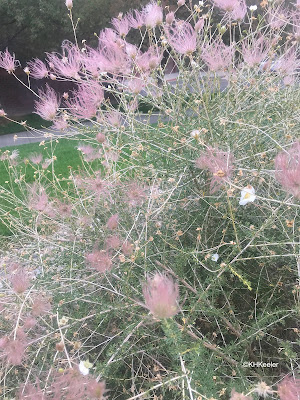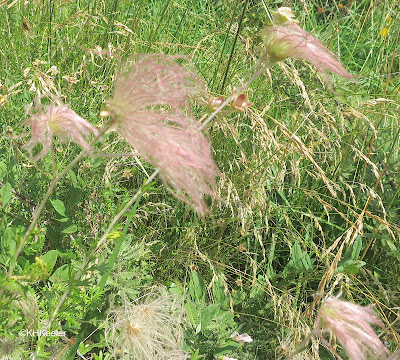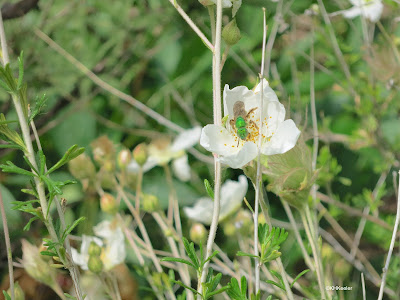Apache plume (Fallugia paradoxa, rose family, Rosaceae) is a native shrub of the southwest, found from Colorado and Texas west to California and Arizona and in neighboring areas of Mexico. It is a pretty shrub with white flowers and distinctive clusters of long-lasting cream or pinkish fruit resembling plumes.
 |
| Apache plume, Fallugia paradoxa |
It is called Apache plume because the fruits, single-seeded fruits called achenes, are elongate and feathery. Some sources say because they resemble Apache headdresses. Of the online photos reputed to be Apaches, a few have headdresses reminescent of Apache plume's achenes, but other photos show full warbonnets which I don't think look like Apache plume, or Apaches in bandanas. Apache plume certainly grows across Apache lands... and a lot of other tribes' lands. I can't tell if the name is fanciful or not. Other common names are ponil, yerba del pasmo, and barba de chivo.
 |
| Apache plume seed heads |
Flowers are 2" across, white, flat, open flowers with five petals, very characteristic of rose family plants. They attract lots of bees, from small native bees to bumblebees to honeybees.
The leaves are divided, short and stubby, to me like small many-fingered gloves. Apache plume is good winter brouse for deer though otherwise not eaten much by livestock or wildlife. The seeds are eaten by birds.
It is tolerant of hot dry conditions. You can find it thriving where it was planted north and east of its traditional rang. It will likely be resilient to climate change. It survives brief severely cold temperatures as well.
The Ramah Navajo used Apache plume as a ceremonial ememtic. The Tewa made an infusion of leaves for a shampoo to encourage hair growth. The wood was used by a number of tribes in the Southwest to strengthen baskets and as handles on items like cradleboards. Straight branches were shaped into arrow shafts. The leafy stems served as brooms.
Quite a beautiful native shrub.
Comments and corrections welcome.
References
Charters, M. J. 2005. California Plant Names: Latin and Greek Meanings and Derivations. www.calflora.net link (Accessed 11/30/23)
Cretti, J. L. 1998. Colorado Gardeners' Guide. Cold Springs Press, Inc. Franklin, Tennessee.
Fallugia paradoxa. Fire Effects Information System (FEIS) U.S.DA./US Forest Service. link (Accessed 12/2/23).



No comments:
Post a Comment